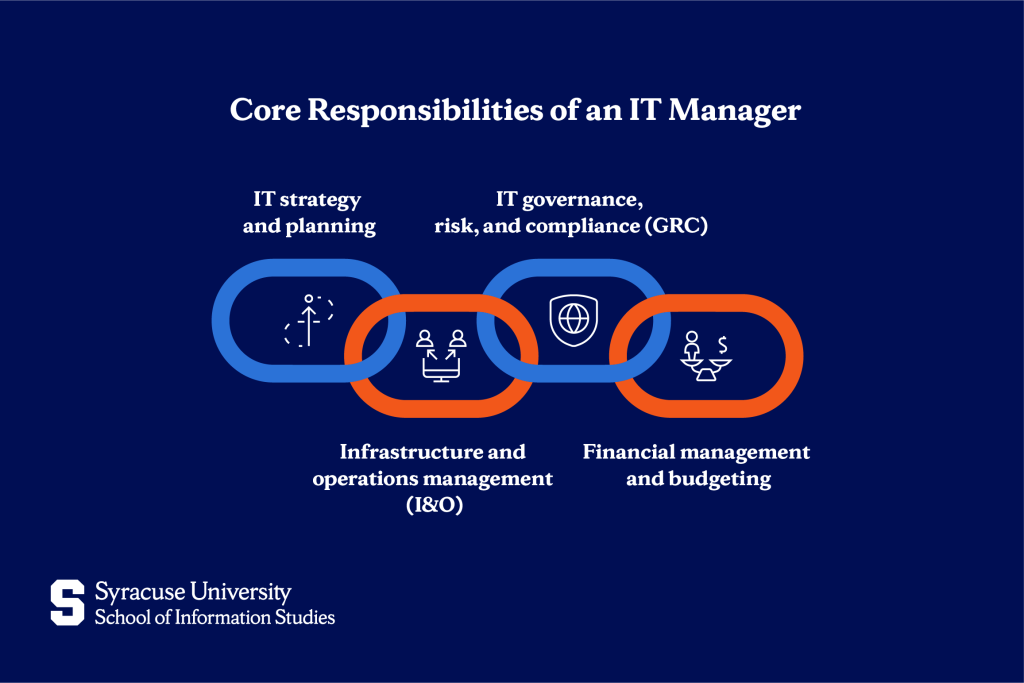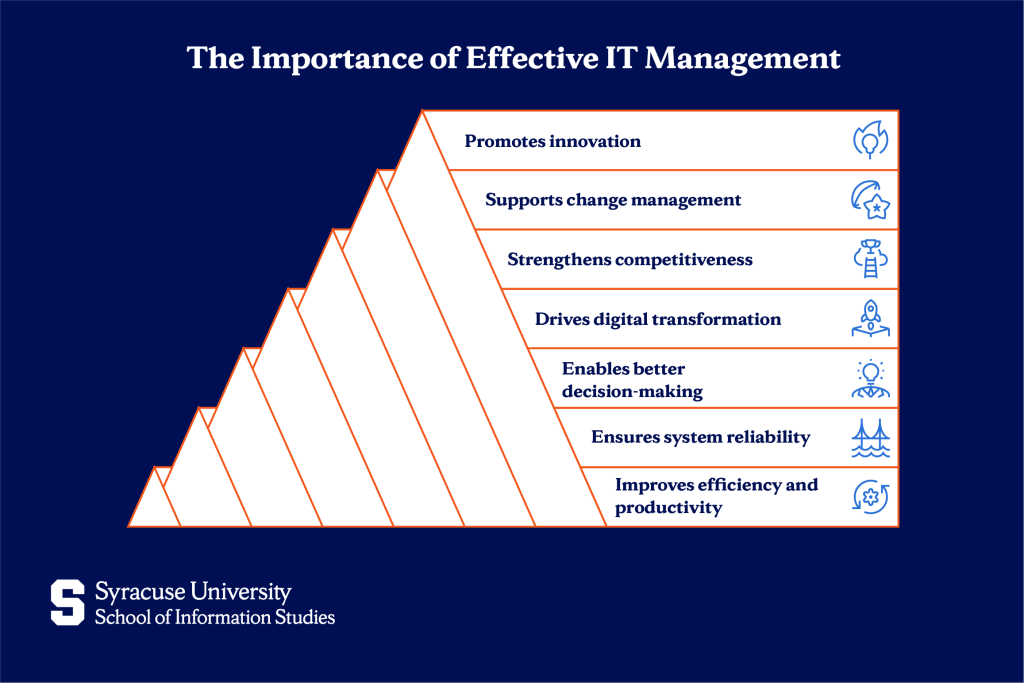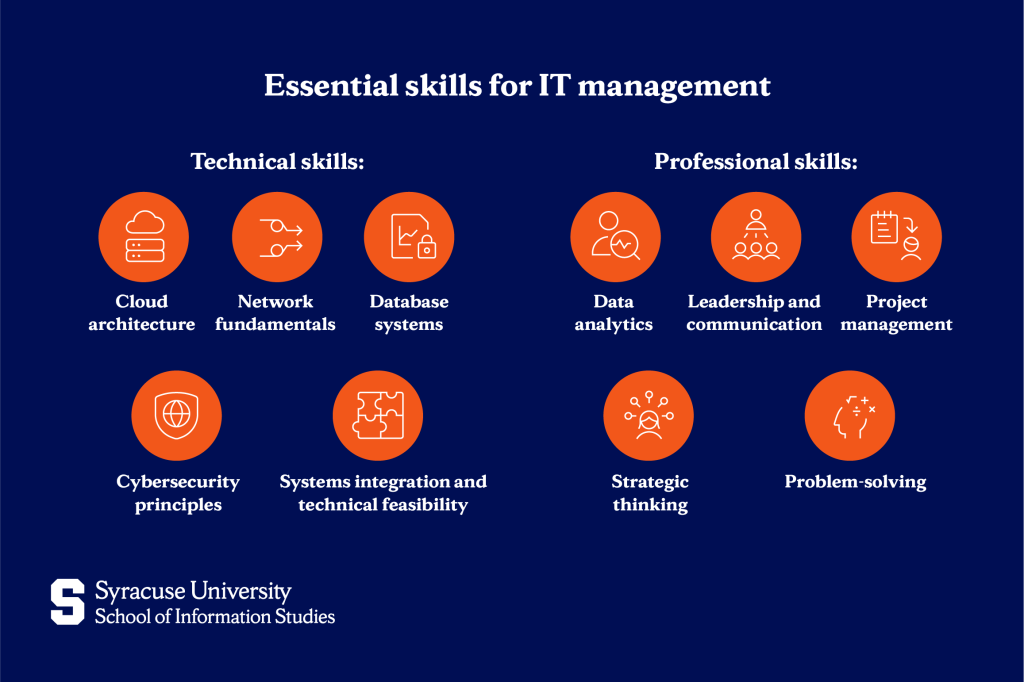Key Takeaways
- IT managers oversee: strategy, operations, governance, and financial management.
- Career paths in information technology management range from IT Project Manager to CIO, requiring both technical expertise and leadership skills.
- Effective ITM drives operational efficiency, digital transformation, and competitive advantage across all industries.
Information technology management (ITM) involves using and overseeing technology to meet a company’s goals. More than fixing computers or troubleshooting issues, ITM includes strategic resource planning, budgeting, risk management, and service delivery that keeps businesses running smoothly and competitively.
In the digital economy, organizations use technology for everything from customer relationship management to supply chain coordination. IT managers are the link between these technical systems and broader business goals. They ensure every technology investment supports measurable outcomes like cost reduction, market expansion, or regulatory compliance.
What is Information Technology Management?
At its core, ITM involves making strategic decisions about which technologies to adopt, how to deploy them efficiently, and how to measure their impact on business performance. IT managers must understand both the technical architecture of systems (cloud platforms, databases, network infrastructure) and also the business context in which those systems operate.
For example, think of a retail company implementing a new customer relationship management (CRM) system. An IT operations team might handle the installation and maintenance, but an IT manager ensures the CRM integrates with existing inventory systems, trains staff effectively, stays within budget, and ultimately improves customer retention rates.
The field draws on frameworks like ITIL (Information Technology Infrastructure Library) for service management and COBIT (Control Objectives for Information and Related Technologies) for governance, providing structured approaches to managing complex technology environments.
Key Functional Areas and Responsibilities of an IT Manager
IT managers handle a diverse set of responsibilities that turn high-level strategies into daily actions. Here’s how these core functions work in practice:

IT strategy and planning
Strategic IT planning involves aligning technology initiatives with business objectives through careful analysis and roadmapping. IT managers evaluate potential system implementations, like enterprise resource planning (ERP) or customer relationship management (CRM) platforms, to determine which investments will deliver the greatest business value.
This process includes IT portfolio management, where managers prioritize competing technology projects based on factors like expected return on investment, strategic importance, resource availability, and risk level. A financial services firm, for example, might prioritize a cybersecurity upgrade over a new internal communications tool if regulatory compliance is at stake.
IT managers also track technology trends to identify opportunities before competitors. This means staying informed about developments in cloud computing, artificial intelligence, and industry-specific solutions that could provide competitive advantages.
Infrastructure and operations management (I&O)
Infrastructure and operations management ensures the reliable delivery and maintenance of technology services that organizations depend on daily. This includes physical hardware like servers and networking equipment, cloud platforms, and end-user support through the service desk.
IT managers implement IT service management (ITSM) principles to handle incidents, problems, and changes systematically. When a critical system fails, incident management steps in to restore service quickly. Problem management investigates root causes to prevent recurrence. Change management ensures updates don’t introduce new issues.
Service level agreements (SLAs) formalize performance expectations. An SLA might guarantee 99.9% uptime for email systems or promise that 80% of help desk tickets will be resolved within four hours. Managers monitor these metrics continuously and take corrective action when performance slips.
When infrastructure and operations function efficiently, employees barely notice the technology supporting their work.
IT governance, risk, and compliance (GRC)
IT governance, risk, and compliance establishes the policies and oversight structures that ensure technology is used ethically, legally, and effectively. IT managers create and enforce frameworks that define who has authority to make technology decisions, how security standards are maintained, and how the organization responds to technology-related risks.
Frameworks like COBIT (Control Objectives for Information and Related Technologies) provide structured approaches to IT governance, defining processes for technology planning, acquisition, delivery, and monitoring. ISO 27001 (International Organization for Standardization 27001) offers standards for information security management systems. IT managers adapt these frameworks to their organization’s specific needs and industry requirements.
Compliance management deals with rules and regulations that differ across industries and regions. Healthcare organizations must follow HIPAA (Health Insurance Portability and Accountability Act) to protect patient data. Companies in Europe comply with GDPR (General Data Protection Regulation) for personal data.
Risk management involves identifying potential threats, such as cyberattacks, system failures, and data breaches, and implementing controls to mitigate them. This includes conducting regular security audits, maintaining disaster recovery plans, and ensuring business continuity protocols are tested and current.
IT managers also establish ethical guidelines for technology use, addressing questions about employee monitoring, data usage, algorithmic bias, and environmental sustainability.
Financial management and budgeting
Financial management transforms technology from a cost center into a strategic investment. IT managers develop and manage budgets, negotiate vendor contracts, and demonstrate the business value of technology spending to executive leadership.
The IT budget usually separates spending into two main types:
- Capital Expenditures (CapEx): One-time costs for major purchases like servers, hardware, or large system upgrades.
- Operating Expenditures (OpEx): Ongoing costs such as software subscriptions, maintenance, and staff salaries.
With cloud computing, many companies now prefer the OpEx model because it replaces big upfront costs with steady monthly payments.
Total Cost of Ownership (TCO) analysis reveals the true cost of technology decisions by including implementation, training, maintenance, support, and eventual replacement costs, in addition to purchase prices. A “free” open-source software solution might actually cost more than a commercial alternative once you factor in customization and ongoing support requirements.
Vendor management focuses on securing the best value through balanced contracts, competitive bids, and strong supplier relationships. By managing costs and partnerships effectively, IT managers become strategic partners to leadership instead of simply handling technology requests.
Why Effective IT Management Matters
Strong IT management helps organizations work efficiently, remain competitive, and adapt to change. It turns technology into measurable business value through improved productivity, reliability, and innovation.

Enhancing operational efficiency and productivity
When systems work together, employees spend less time on repetitive tasks and more time on meaningful work. For example, connecting production and inventory systems lets manufacturers automatically adjust supply orders, reducing shortages and excess stock. Automation tools like robotic process automation (RPA) handle tasks such as data entry and report generation, freeing employees to focus on strategic goals.
System reliability is also important. Every hour of unplanned downtime means lost productivity and customer frustration. Well-managed IT operations achieve 99.9% or higher uptime, ensuring systems are ready when needed. Integration across tools like CRMs and accounting software also improves accuracy and decision-making by keeping data consistent and current.
Driving digital transformation and competitive advantage
Digital transformation depends on IT leaders who align technology with business strategy. These managers evaluate emerging tools like artificial intelligence, Internet of Things (IoT), and blockchain to identify where these can improve performance or customer experience.
A retailer, for instance, might use IT management to build an omnichannel platform that lets customers browse online, check in-store inventory in real-time, order for home delivery or in-store pickup, and manage returns through any channel. This digital transformation attracts customers and strengthens competitiveness.
Similarly, IT-driven innovations like mobile apps or IoT sensors can improve efficiency, reduce waste, and support continuous improvement.
Change management is critical during digital transformation. IT managers work with department heads to ensure employees understand new systems, adopt them effectively, and realize the full potential of technology investments. The best technology fails if people don’t use it properly.
Building a Career in Information Technology Management
ITM offers diverse career paths for professionals who combine technical expertise with strategic thinking and leadership skills. Here’s what you need to succeed and where the field is heading:
Essential skills
Success in IT management requires a foundational understanding of cloud architecture (AWS, Azure, Google Cloud), network fundamentals, database systems, and cybersecurity principles. You don’t need to code production applications, but you should understand how systems integrate and what’s technically achievable.

Beyond technical know-how, effective IT managers rely on a diverse set of professional skills, such as:
- Data analytics: Understand performance metrics, track technology spending, and use data to guide decisions and recommendations.
- Leadership and communication: Lead cross-functional teams, negotiate with vendors, and explain technical ideas in simple business terms.
- Project management: Plan and deliver projects on time and within budget using methods like PMP (Project Management Professional) or Agile.
- Strategic thinking: Link technology choices to business goals, plan for future needs, and position IT as a strategic partner.
- Problem-solving: Handle system failures, budget limits, and competing priorities by finding practical, creative solutions.
Common IT management roles and career trajectory
IT management careers usually progress through several stages that expand in scope and strategic responsibility:
IT Project Manager – focuses on delivering specific, time-bound initiatives. You’ll manage teams implementing new systems, oversee technology upgrades, coordinate with vendors, and ensure projects meet objectives within budget and timeline constraints. This develops your ability to balance technical requirements with business goals while building relationships across the organization.
IT Manager – shifts focus to ongoing operations and team leadership. You’ll supervise technical staff, manage departmental budgets, ensure service delivery meets SLAs, and handle daily technology challenges. The role deepens your understanding of how IT supports business operations and develops your ability to build and lead effective teams.
IT Director – expands responsibility across multiple functional areas or technology domains. You’ll develop departmental strategy, manage larger budgets, interface regularly with executive leadership, and make decisions about technology investments and organizational structure.
Chief Information Officer (CIO) or Chief Technology Officer (CTO) – represents IT at the executive level. You’ll define the organization’s overall tech vision, plan long-term strategies, and manage major technology investments. While CIOs usually focus on internal systems and operations, CTOs often handle product technology and innovation.
Future Trends in Information Technology Management
Here are some of the most recent developments that are transforming IT management as a whole:
- Artificial Intelligence in IT Operations (AIOps) now automates many tasks that IT managers once handled manually. AI-powered tools can predict system failures before they occur, optimize resource use automatically, and fix common problems without human input.
- Cloud-native management has shifted IT management from maintaining physical infrastructure to coordinating services across multiple cloud platforms. Today, IT managers focus more on service integration, API management, and creating seamless hybrid environments than on managing server rooms.
- Automation expands beyond operations into governance and compliance. Modern tools continuously monitor systems for security risks, compliance breaches, and policy violations, alerting teams in real time instead of relying on annual reviews.
- Cybersecurity leadership has become a core responsibility as threats grow more advanced and regulations tighten. IT managers now treat security as a strategic business concern, ensuring it receives attention at the board level.
- Sustainability considerations influence technology decisions. Organizations track and reduce the carbon footprint of technology infrastructure, pressure cloud providers for renewable energy commitments, and consider environmental impact alongside traditional factors like cost and performance.
These trends don’t replace IT managers; they redefine their role from hands-on oversight to strategic leadership. Those who adopt new technologies, strengthen their business understanding, and keep expanding their skills will see rising opportunities as organizations depend more heavily on technology for competitive advantage.
The Bottom Line
Information technology management connects technology with business success. IT managers who combine technical skills with strategic leadership improve efficiency, lead digital transformation, and create advantages that help companies compete and grow.
As organizations across every industry increase their dependence on technology, career opportunities in information technology management continue to expand. Syracuse University iSchool’s Information Management and Technology Bachelor’s Degree and Master’s Degree in Information Systems prepare you for ITM roles, offering hands-on experience with enterprise systems, guidance from faculty who work with Fortune 500 companies, and access to a global network of IT leaders transforming organizations worldwide.
Frequently Asked Questions (FAQs)
What does a typical day look like for an information systems manager?
You’ll split time between strategic planning meetings, reviewing system performance metrics, troubleshooting urgent issues, and communicating with stakeholders across the organization; balancing immediate operational needs with long-term technology planning.
Are there specific degrees or certifications required or recommended for IT management roles?
Most IT management roles require a bachelor’s degree in IT, computer science, or a related field, and many employers prefer a master’s in IT management or an MBA. Certifications like PMP, ITIL, CompTIA, or CISM are also highly valued and help demonstrate leadership and technical expertise.
How do you effectively organize and prioritize tasks as an IT manager?
Use frameworks like the Eisenhower Matrix to distinguish urgent from important tasks, implement project management tools to track competing initiatives, and align priorities directly with business objectives so stakeholders understand and support your decisions.
Does an MBA in information technology management help you land technical roles?
An MBA in IT management typically positions you for strategic leadership roles (IT Director, CIO) rather than hands-on technical positions. It is valuable for advancing into business-focused IT leadership but less relevant for specialized technical careers.
